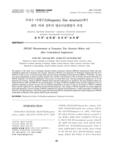

PARTNER
검증된 파트너 제휴사 자료
주파수 미세구조(frequency fine structure)에서 대측 억제 전후의 변조이음향방사 측정
방대한 850만건의 자료 중 주제별로 만들수 있는 최적의 산출물을 해피 캠퍼스에서 체험 하세요 전문가의 지식과 인사이트를 활용하여 쉽고 폭넓게 이해하고 적용할수 있는 기회를 놓치지 마세요
12 페이지
최초등록일 2015.03.25
최종저작일
2012.01

-
 * 본 문서는 배포용으로 복사 및 편집이 불가합니다.
* 본 문서는 배포용으로 복사 및 편집이 불가합니다.
미리보기
서지정보
· 발행기관 : 한국청각언어재활학회
· 수록지 정보 : 청능재활 / 8권 / 2호
· 저자명 : 김지연, 심현용, 김진숙, 남의철
목차
INTRODUCTION
MATERIALS AND METHODS
RESULTS
DISCUSSIONS AND CONCLUSIONS영어초록
The purpose of this study was to investigate distortion product otoacoustic emission (DPOAE) measurements before and after
contralateral suppression at frequency fine structure. 8pts/octave DP-gram was measured at f2 frequencies ranging from 841 Hz to
8,000 Hz in fifty six ears of normal hearing adults with and without contralateral broad band noise (BBN) at 70 dB SPL. The data
were analyzed depending on groups by gender, age(20's, 30's, and 40's+) and directions of the ear. Results showed the followings: (1)
DPOAE amplitude was decreased significantly with presence of broad band noise, showing contralateral suppression. (2) At the
frequency fine structure, change in DPOAE amplitude before and after suppression was significant. The great amplitude change was
observed between 1,000 and 2,000 Hz for most participants. (3) Change in DPOAE amplitude before and after suppression was not
significant depending on gender and age, but was significant depending on directions of the ear. (4) Change in DPOAE amplitude
before and after suppression was significant for peak and dip frequencies. Also, change in DPOAE amplitude was mostly suppressed
at the peak frequencies, however, change in DPOAE amplitude was varied at the dip frequencies. A larger inter-subject variability was
observed in the dip frequencies. The results suggest that measuring DPOAE contralateral suppression at peak frequencies in DPOAE
would improve efficiency of the auditory efferent system assessment.참고자료
· 없음태그
-
자료후기
-
자주묻는질문의 답변을 확인해 주세요

꼭 알아주세요
-
본 학술논문은 (주)학지사와 각 학회간에 저작권계약이 체결된 것으로 AgentSoft가 제공 하고 있습니다.
본 저작물을 불법적으로 이용시는 법적인 제재가 가해질 수 있습니다. -
해피캠퍼스는 구매자와 판매자 모두가 만족하는 서비스가 되도록 노력하고 있으며, 아래의 4가지 자료환불 조건을 꼭 확인해주시기 바랍니다.
파일오류 중복자료 저작권 없음 설명과 실제 내용 불일치 파일의 다운로드가 제대로 되지 않거나 파일형식에 맞는 프로그램으로 정상 작동하지 않는 경우 다른 자료와 70% 이상 내용이 일치하는 경우 (중복임을 확인할 수 있는 근거 필요함) 인터넷의 다른 사이트, 연구기관, 학교, 서적 등의 자료를 도용한 경우 자료의 설명과 실제 자료의 내용이 일치하지 않는 경우
문서 초안을 생성해주는 EasyAI
